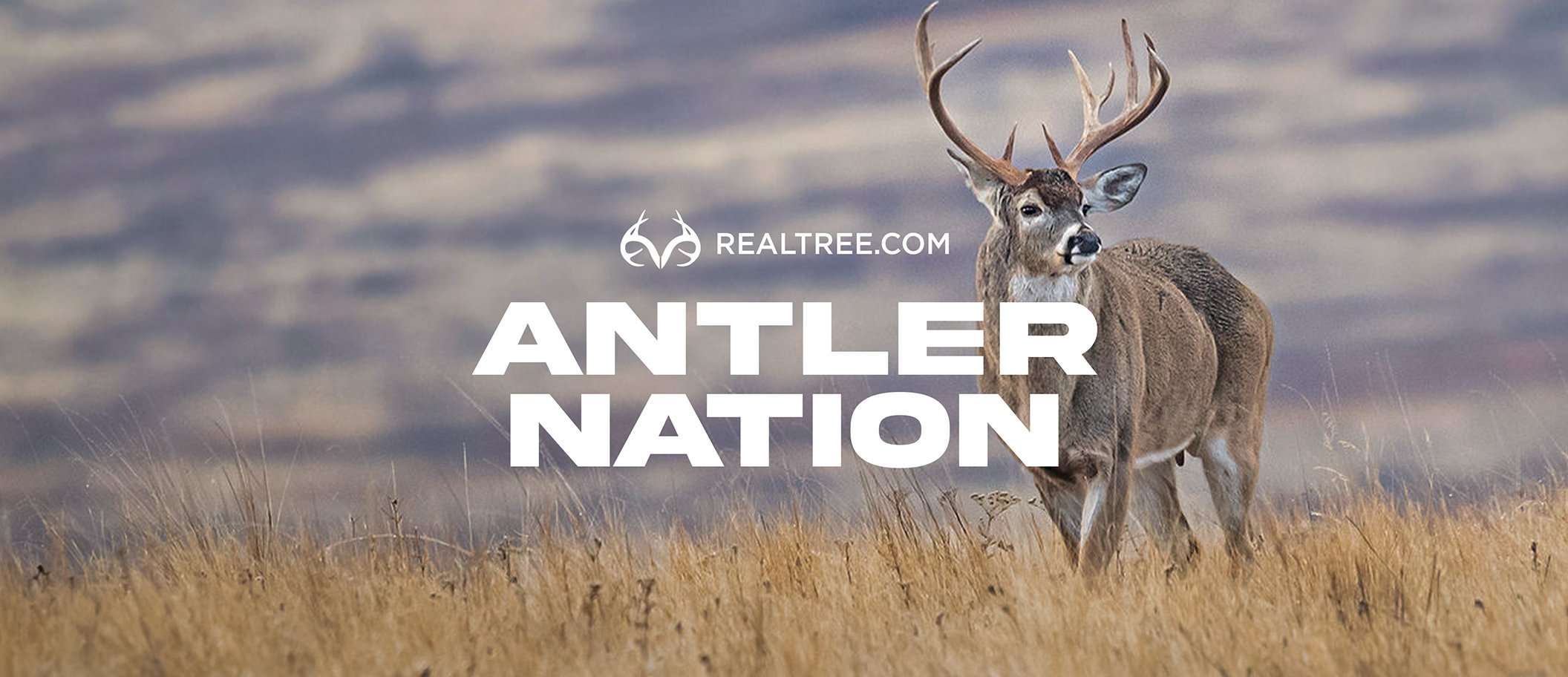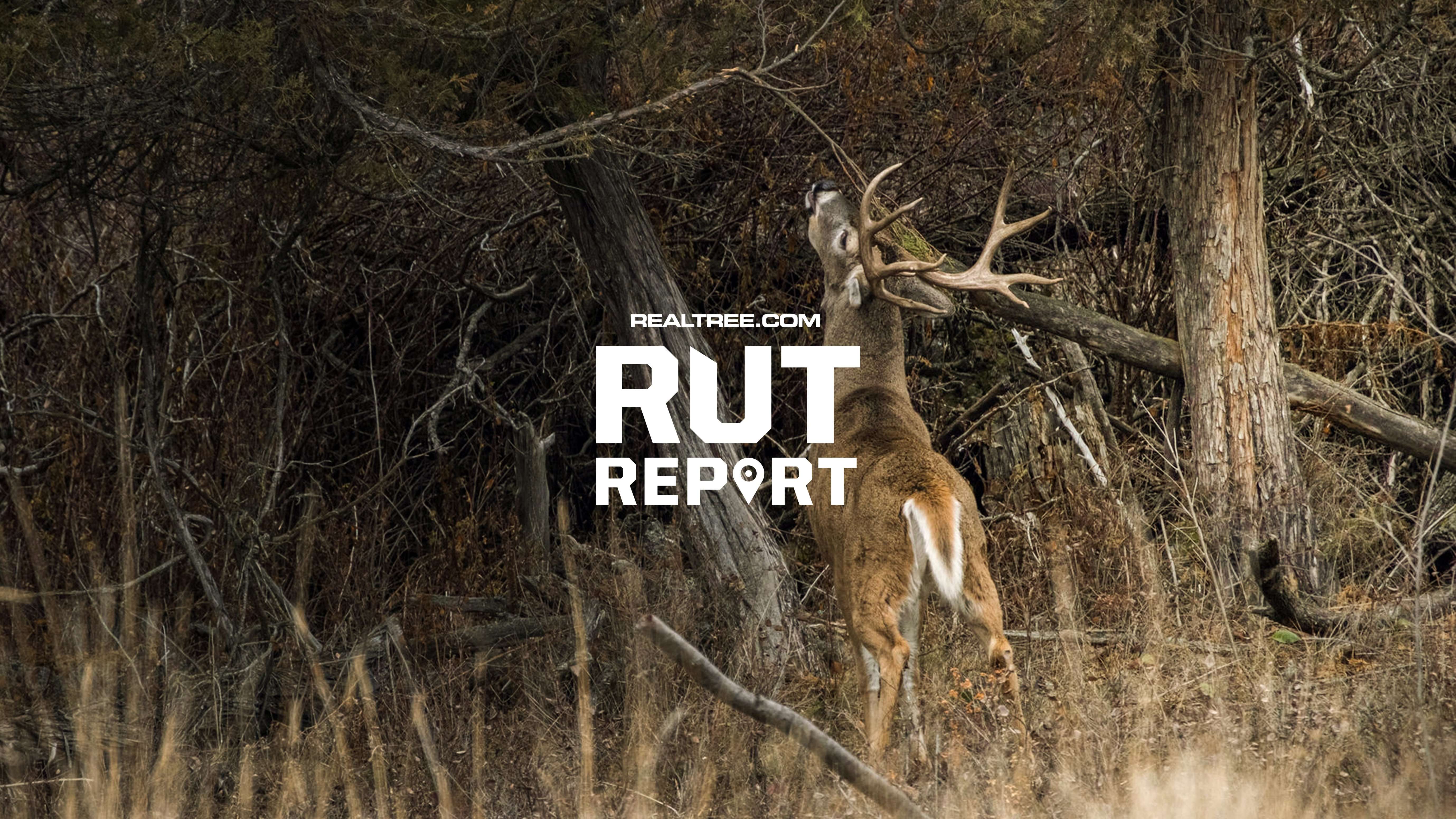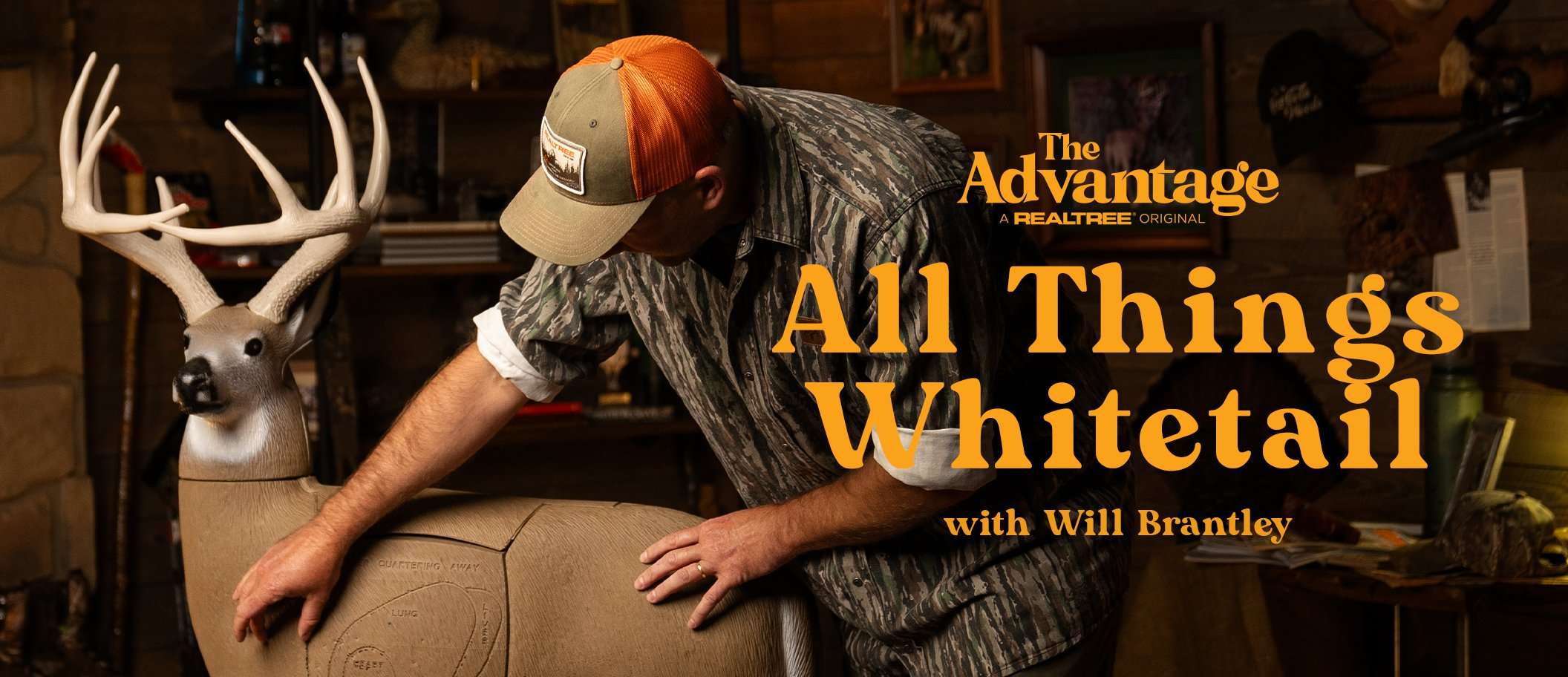This revolutionary ignition system has made muzzleloaders more consistent, accurate, and weather-proof than ever before
Muzzleloading rifles have been around since the 18th century, and hunters and rifle makers have been trying to improve them ever since. From the very first flintlocks to the early caplocks to modern inlines rifles — which have been around now for almost 40 years — muzzleloading hunters have long sought better reliability, faster loading, better accuracy and increased resistance to inclement weather conditions.
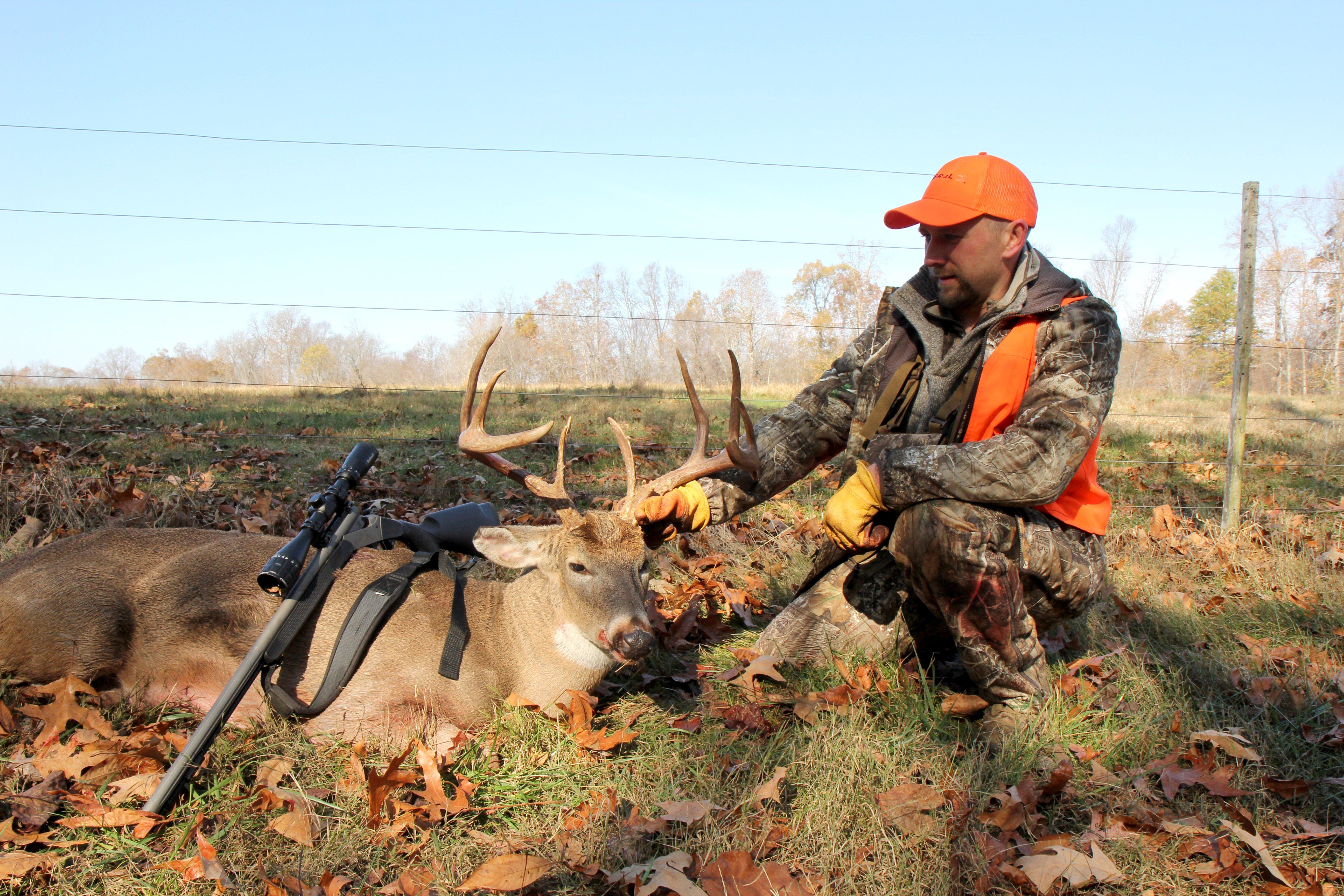
Special muzzleloader-only seasons give hunters more time in the field, often during the best time of year. This big Tennessee buck was taken in early November during the muzzleloader season. Photo by Will Brantley
While the one constant through the entire evolution has been a bullet loaded from the muzzle end of the firearm, the ignition systems have seen plenty of upgrades, including bolt-action and break-action inlines; better, cleaner powders, and pre-formed, pelletized powder charges. One of the most revolutionary advancements has been the FireStick from Federal Premium, a self-contained propellant system that was originally launched in conjunction with the Traditions NitroFire muzzleloader. Due to the success of that launch, FireStick muzzleloaders have been legalized in most eastern and midwestern states during muzzleloader-only seasons. A number of other FireStick muzzleloaders are now available to hunters, too, including the CVA Crossfire, which is available in Realtree camouflage patterns.
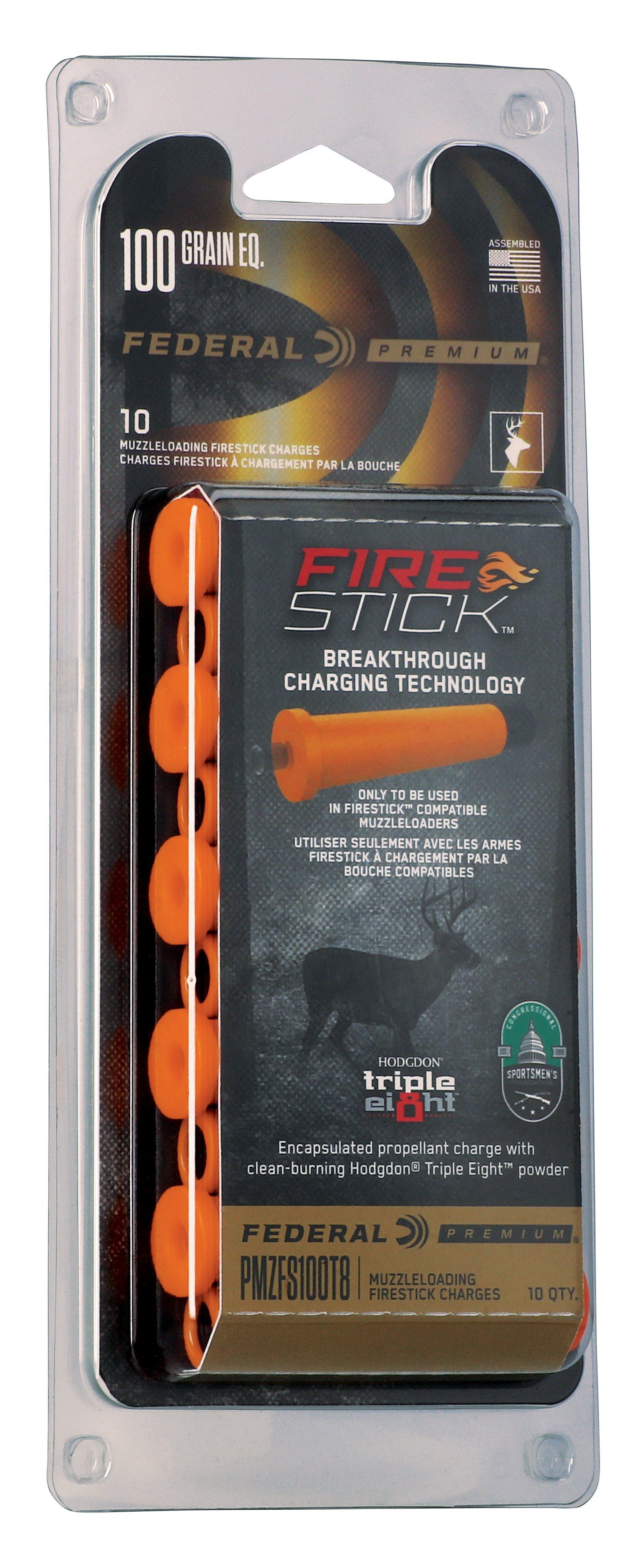
Federal FireSticks are available in several different powder charge volumes. Image by Federal Ammunition
The FireStick system takes modern muzzleloading powders to another level of convenience with self-contained polymer cases that accept No. 209 primers and load from the breech of rifles designed for the system. The benefits are almost complete waterproofing, more consistent pressure from shot to shot, and the ability to quickly and easily unload a rifle in seconds without firing it. The loads are available in pre-measured charges of 80, 100, or 120 grains of Hodgdon Triple Eight powder.
FireStick muzzleloaders are manufactured with a small rim shelf at the end of the breech, and the bullet is seated against that rim with a ramrod, just as you’d load any other break-action, inline muzzleloader. The difference is in the breech-loaded powder charge.
Don’t Miss: Slug Guns vs. Straight-Wall Rifles
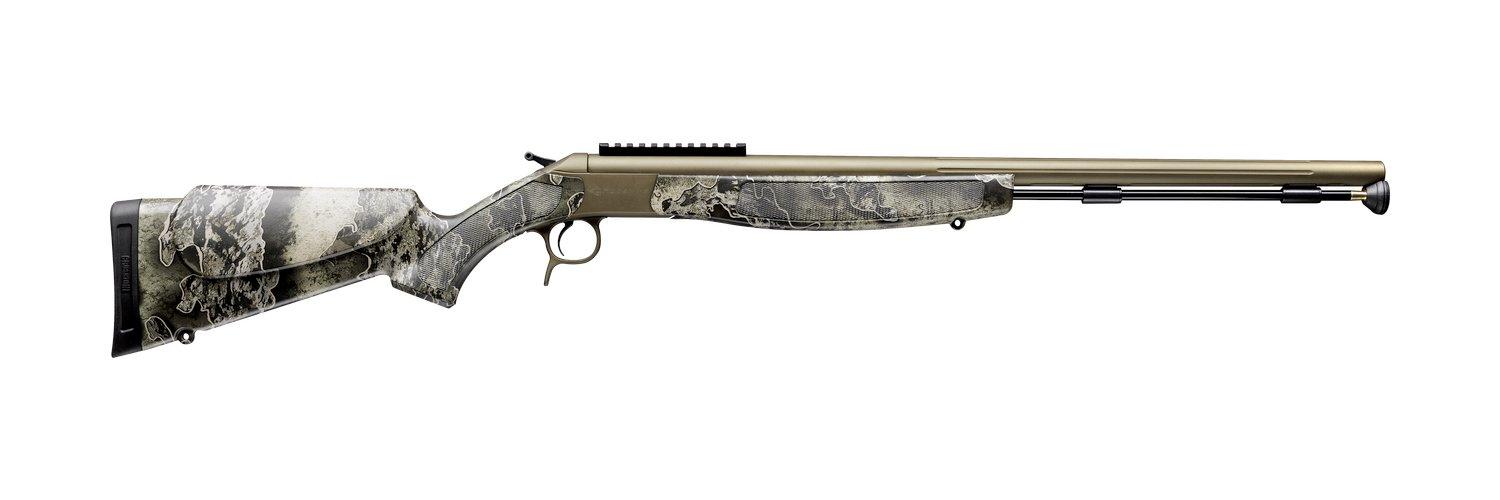
Currently, rifles from CVA and Traditions are designed to shoot the Firestick system. Image by CVA
I recently did some testing with all three FireStick sizes through a Traditions NitroFire with a couple different bullet styles, including a 250-grain sabot and a 350-grain Federal Bor-Lock. It is worth noting that Federal does not recommend bullet weights of 350 grains or heavier with the 120 grain Firestick powder charges as the combination may exceed recommended chamber pressures.
THE HITS
- Accuracy
I’ve been shooting muzzleloader rifles for nearly 40 years. I’ve shot flintlocks with patched round balls, cap locks with full bore lead bullets and saboted modern bullets, and inlines of nearly every brand with a wide variety of powder and bullet combinations. One of the main issues I have had with each and every style is consistent accuracy from shot to shot. Many would shift point of impact several inches from one shot to another depending on how many shots had been fired since cleaning or how much downward pressure I put on the bullet when seating the load. But the FireStick rifle was accurate from shot to shot with both bullet weights and all three charges. The combination of pre-packed, polymer encased loads and the shelf to seat the bullet against resulted in a perfect load every time. The Hodgdon Triple 8 proved to be clean burning, resulting in consistent POI even after multiple shots without cleaning.
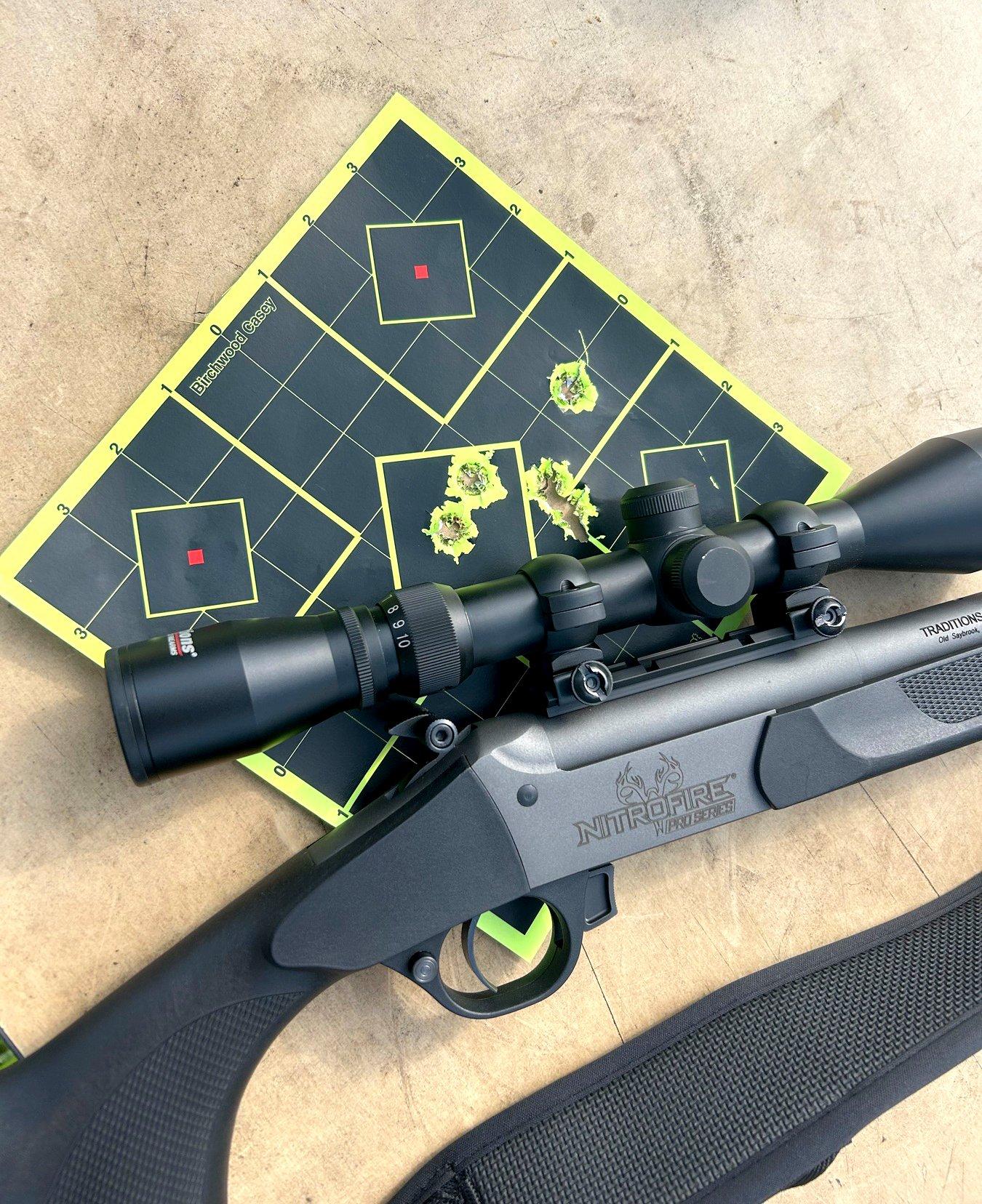
Accuracy with all three loads was outstanding, taking only three to five shots to zero the rifle. Image by Michael Pendley
- Weather Resistance
Blackpowder and most blackpowder substitutes are extremely hydroscopic. They soak moisture like a sponge. With old cap locks and especially flint locks, any moisture in the air at all and chances were better than average that your gun wouldn’t fire when you squeezed the trigger.
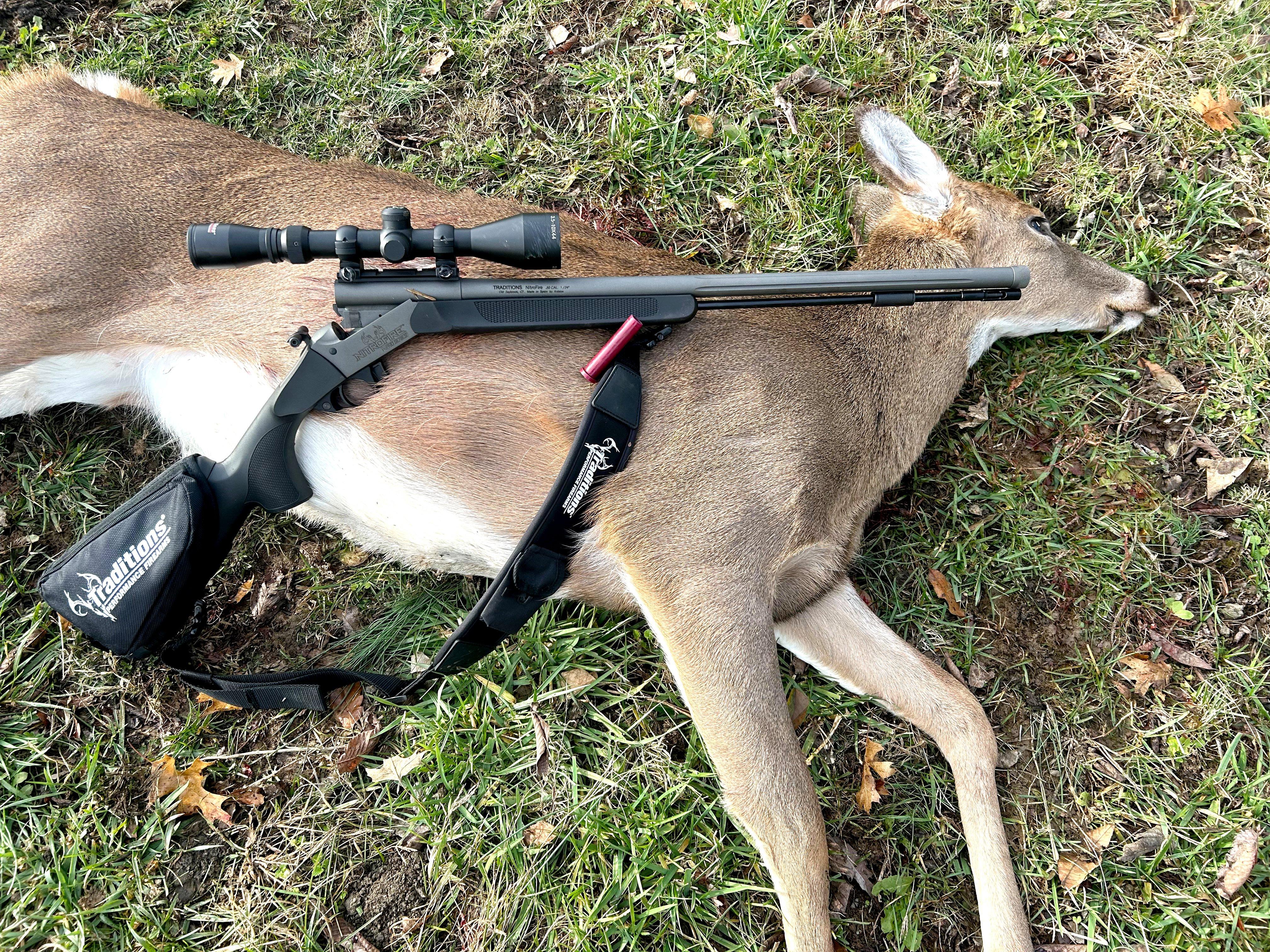
The closed powder system makes these muzzleloader loads virtually weatherproof, allowing you confidently hunt in any conditions. Image by Potroast Pendley
Modern inlines helped immensely with this issue, but a serious downpour or a couple of days of steady rain could still be enough to dampen your charge to the point that it wouldn’t fire. The FireStick charges take moisture completely out of the equation. How waterproof are they? I soaked a couple in a bucket of water for 15 minutes, took them out and dried them off, then loaded and fired. No issues at all. There have been days when I passed on a muzzleloader hunt because of foul weather. Not anymore. I’ll be confident hunting in the heaviest of rain storms with this rifle.
Don’t Miss: Hunting with the Federal 7mm Backcountry
- Safety
Unlike traditional muzzleloaders that have to be fired to unload, or inlines that have to have the breech plug removed and the powder dropped out to be rendered completely unloaded (although most state regs say just removing the primer or cap is sufficient), the FireStick system allows the shooter to remove the powder charge by simply opening the gun and taking out the powder charge, rendering the rifle completely safe to transport.
Another safety issue with old style muzzleloaders, caplocks and flintlocks in particular, is double loading or overcharging with too much powder. Unless you mark your fully loaded level on your ramrod, it’s sometimes tough to tell if there is a load already in the gun. In more than a few instances, hunters have forgotten, or in the excitement of the hunt, loaded a stacked double charge down the barrel, with sometimes catastrophic results. With the FireStick, simply open the gun to check the powder charge.
- Cleaning
One of the most common complaints with muzzleloader rifles has always been the cleaning process. With the earliest guns, especially those using true black powder, the guns had to be cleaned after each use or risk accuracy killing corrosion.
My earliest caplocks required soaked patch after patch down the barrel until they finally came out clean, followed by dry patches and then lube to protect the barrel.
Modern inlines made the process easier with removable breech plugs and cleaner burning powders, but still suffered from sometimes hard to remove “crud rings” that would often cause a ring of corrosion in the barrel if not completely removed.
The Nitrofire is the easiest muzzleloader I’ve ever cleaned. First, there is no breech plug to remove, soak, and scrub. Next, the fully contained powder charge and the fact that the bullet seats on a shelf just above the powder charge left no perceptible crud ring. The Triple Eight powder was incredibly clean burning. I fired 10 shots through the gun without cleaning and POI never changed, and bullets were still easy to load.
Don’t Miss: 8 REASONS WHY FOOD PLOTS FAIL
THE MISSES
- A New Rifle is Required
If you are going to hunt with this system, you are going to do it with one of the rifles designed for it. The FireStick charge isn’t compatible with your existing breech plug style muzzleloaders. If you had plans for a new rifle anyway, this isn’t a big deal. If you’ve purchased a muzzleloader recently, doing it again might not be an option right away.
- Cost Per Shot
At $38 per pack of 10 charges, FireSticks aren’t cheap when compared to traditional Pyrodex or even more expensive powders like Blackhorn 209. Coupled with a premium bullet, and gone are the days of being able to shoot your muzzleloader all day for less than the cost of a fast food lunch.
That said, unless I’m testing new powder / bullet combinations, I rarely shoot my muzzleloaders more than a handful of times per year to check zero, then just a few while hunting. With the FireStick’s consistency, I could see that number going down even more.
- Legality
As mentioned above, there are still quite a few states that don’t allow the FireStick system to be used during traditional muzzleloading only seasons, so check regulations wherever you’re hunting before taking one out. Also, because the powder charge loads from the breech, the guns are not considered antique firearms and therefore a Form 4473 and background check is required for transferring a FireStick muzzleloader, same as it is for a modern firearm.
MORE RESULTS FROM THE RANGE
The rifle I used for testing came topped with a 3.5x10 scope. It had an adjustable length of pull by way of spacers that can be added or removed, and an adjustable cheekpiece that could be raised or lowered by simply turning a screw in the side of the stock. I had multiple people shoot the gun for the range test and everyone was able to make the rifle fit them well. The gun had a 26” Chromoly steel fluted and tapered barrel. And was fitted with the Traditions Elite XT trigger system.
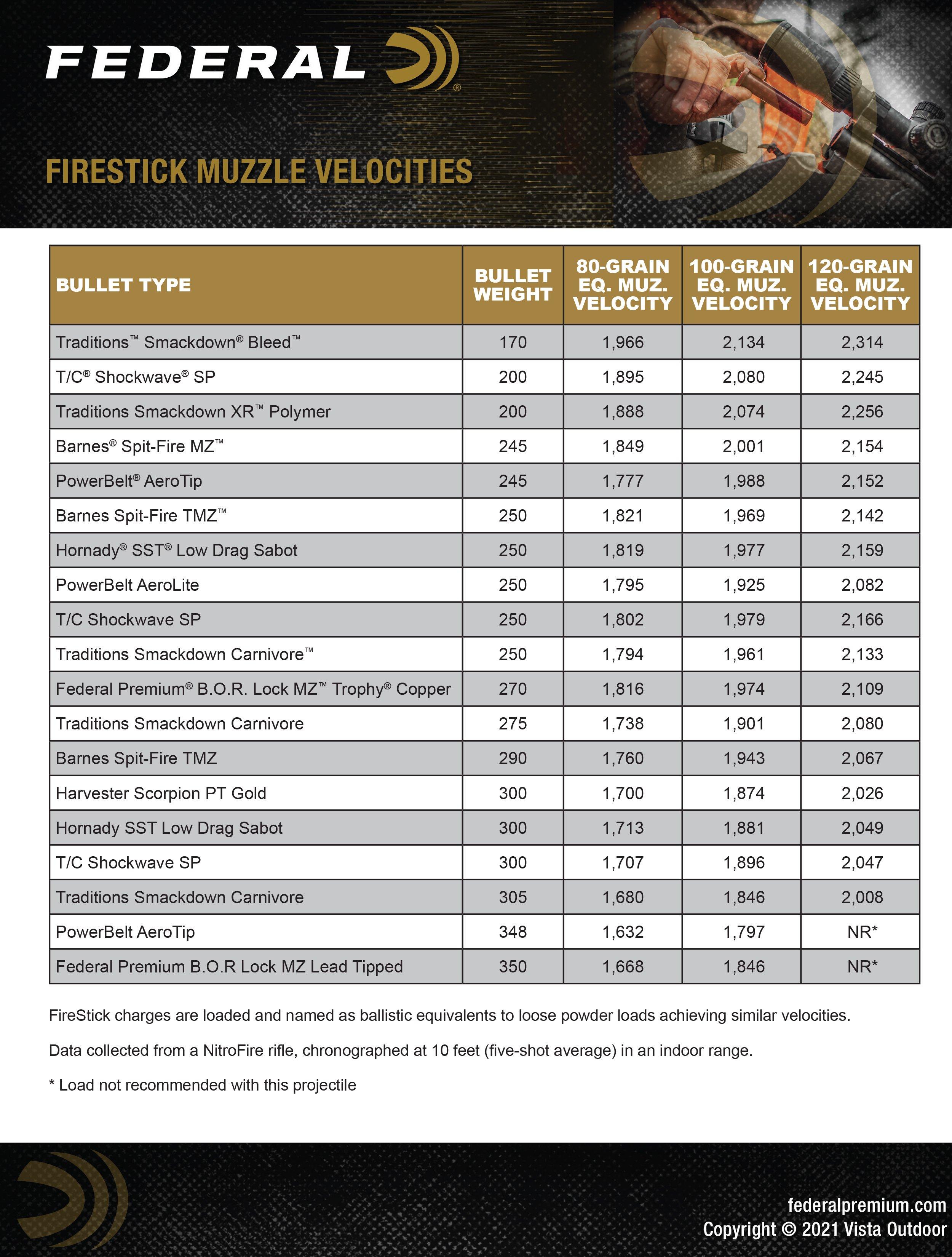
Federal offers this handy chart with ballistics for each load with popular bullets. Image by Federal Ammunition
Accuracy was good, with the 100-grain charge seeming to be the most accurate one of the three. Groups ranged from three-hole cloverleafs up to about 3 inches at 100 yards. The 80-grain loads produced noticeably less recoil. These loads produce some eye-opening velocities, up to 2,300 fps with a 170 grain bullet according to Federal, creating ballistics similar to a .350 Legend straight-walled rifle cartridge.
As mentioned above, the loads were extremely clean. We checked the bore after each shot for the first few rounds. Once we realized that there was little to no fouling, we fired away without cleaning between shots. Accuracy didn’t seem to fall off or opened only very slightly, staying well within range of most hunting situations.
Once we were finished, cleanup was simple. A few cleaner soaked patches down the barrel then a couple to dry and it was done. No breech plug to remove, no primer pocket to scrub clean, and no threads to clean and lube before the next range day. Dare I say it was actually enjoyable?
Does hunting with a FireStick muzzleloader come with same nostalgia of a traditional flintlock or caplock rifle? No, of course not. But for serious hunters looking to extend their time in the field with the easiest, most accurate, most weatherproof muzzleloading system available, it has revolutionized the game.
Don’t Miss: 8 DEER HUNTING TOOLS NO ONE USES ANYMORE




